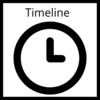Your steps
Click on the steps to expand or collapse. Expand All Steps (+)Step 1: Content
Percent time spent on this step: 50%
A: Understand the assignment (2%)
While reviewing the assignment guidelines and grading requirements, consider the following questions:
- What is the goal of your poster?
- Are there any discipline specific conventions that you need to follow?
- Do you need to prepare a presentation to accompany your poster?
Start by looking at some sample posters from Washington University.
Check out the WCC resource for more information about understanding assignments.
B: Consider your audience (2%)
- If your audience includes experts in your field:
Be brief. When giving a presentation in your field, you can move quickly into the specifics of your research without having to define technical terms or explain the fundamentals. - If you have a non-specialist audience:
Provide more background information. Explain technical terms. Emphasize the importance of your research.
C: Create content (23%)
Conduct research
Gather your information and keep track of your sources as you go along.
- Research strategy worksheet (PDF)
- Conducting research and note taking (PDF)
- RADAR Evaluation Method (PDF)
Organize your information
In general, poster presentations should have about 750 words and include the following sections:
1. Abstract (optional): How would you summarize the research?
2. Introduction: Why are you studying this? What is your research question?
3. Methods: When, where, and how did you do it? What did you use?
4. Research: What did you find? Were you right?
5. Discussion: Why is your study important? What is the next step?
6. Reference List
Due to the limited space of a poster, each section should:
- Be concise,
- Have its own easily identifiable heading.
D: Create visuals (23%)
Good visuals will help explain your subject to people who know little about your topic.
Free programs like Canva or GIMP can help to produce eye-catching images.
You can also use infographics. Infographic templates are readily available on the web.
Data visualizations such as tables, charts, and other images are a common way to share research details. These can turn complex data sets into clear and accessible information.
Free software for data visualization:
- Microsoft Excel
- The R Project for Statistical Computing
- D3 (formerly Data Driven Documents) provides a Javascript library to create your own data visualizations
Step 2: Design
Percent time spent on this step: 40%
A. Make a plan (10%)
Think about size and style
Consider factors that can influence size and style choices:
- When will you present and how much time do you have for design and printing?
- Where will you present and what will be available there? Will the poster sit on an easel, be attached to a wall, or project on a slide?
- Why are you presenting? Is it part of a course, part of an event on campus, or for a conference?
Choose design software
Choose software based on:
- your familiarity with design software,
- availability,
- file format.
PowerPoint is commonly used for poster presentations. Review creating a poster in PowerPoint (PDF). Consider the uWaterloo brand and templates. Consult this handout on brand information (PDF) for more details.
Organize information
Plan the layout of your poster. Organize the information so it is easy for your audience to follow. Don't forget that you'll need to include the author of the work (you!) and any references.
Search online for scientific poster layouts to generate ideas and find templates.
B. Create the poster (25%)
Tips on visual design
- Improve readability by using a clear, dark, legible font over a light background.
- Maximize visual impact by using 2-3 coordinating colours.
- Keep your poster uncluttered.
- If an element isn't helping to clarify your research, consider removing it.
- If you use any text, image, or table that you did not create yourself, it may be subject to copyright restrictions. See the Fair Dealing flowchart (PDF).
Tips for text and headings
Aim for short and to-the-point sentences. Consider using brief bullet points instead of sentences to enhance readability.
Font size:
- The title of your research should be readable from a distance (about 70-120pt). A simple and clever title will generate interest in your work.
- Section headers and subtitles should be about 36-72pt. Body text should be about 50% smaller than the header.
- You can emphasize a few key points through the use of bolding, but don't overdo it.
C. Determine print production (5%)
The most important factors in determining your print production are time and price:
- The printing deadline is the hard deadline for the project. It is a good idea to have this established early. On-campus printing is done through W Print. You will need to give them about 2-3 days for printing.
- An online search of "printing services Waterloo" will provide you with a list of other local vendors.
- The price of printing your poster will vary. Paper weight, size, lamination, and backing are all important factors. Be sure to ask your vendor about these options; you might save some money!
Step3: Presentation
Percent time spent on this step: 10%
Prepare and rehearse a 4-5 minute oral overview of the research presented on your poster.
- Speak clearly.
- Project your voice.
- Make eye contact and interact with your audience.
- Gesture to appropriate visuals.
- Try to anticipate questions.
- Eliminate filler words such as "um", "like" and "you know."
During your presentation, interact with people as they are walking by and ask them if they would be interested in hearing about your research!

